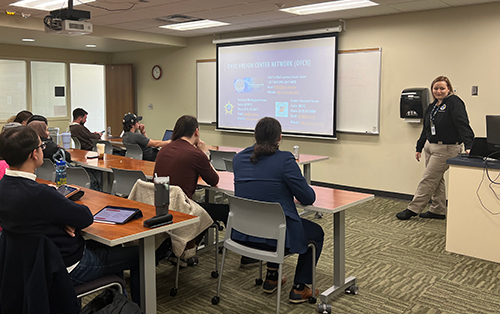Depending on what group students in Dr. Joel Voss’ spring course were put into at the start of the semester, they’re either planning a terrorist attack in Toledo or trying to stop the impending attack before it occurs.
It’s a three-month simulation for a political science class and all about planning — no simulated attack will take place at any location. The simulation is all on paper.

Kelsey Kirkpatrick, an intelligence analyst with Ohio Homeland Security in Columbus, gives a presentation to the political science class during spring semester.
Voss, an associate professor of political science at The University of Toledo, teaches the terrorism course, in collaboration with the Ohio Department of Homeland Security.
“I hope this hands-on experience will get students more involved in the material by showing them how complicated these issues are while also opening up potential career choices in counterterrorism,” Voss said.
Kelsey Kirkpatrick, an intelligence analyst with Ohio Homeland Security in Columbus, visited the class in Toledo and explained how they go about identifying terrorist groups. She also laid out details of a case study on how they were wrong about a potential attack and helped familiarize students with types of weapons that have been used by terrorists.
“Oftentimes through TV shows and movies we are desensitized to the reality of what law enforcement agencies truly do, and Kelsey helped shed light on the efforts of the Department of Homeland Security and other similar government agencies,” said Liam Soules, a fourth-year student studying political science and law and social thought. “Not only did she provide information on what she does, but she also offered us a few post-graduation options that are very realistic.”
Here’s how the class simulation works.
Students are placed into four groups: two attacking groups and two defending groups. One defending group is assigned to one attacking group.
The attacking groups must pick a spot in Toledo and make plans to “attack” it on a specific date with a specific method. The defending groups must try to prevent these attacks by picking the correct location and counter-terrorism methods.
“No one knows who belongs to the other groups, so it is a semester-long process of trying to deduce membership and tactics,” Voss said.
The fake attack date is Thursday, April 20, when they will reveal in class their identities and plans.
When the groups make their in-class presentations, if the plans for assigned corresponding “terrorist” and “counterterrorism” groups match up, the fake attack is foiled. If they don’t match, the attack succeeded.
“It has been a very exciting semester,” Soules said. “The class is essentially paired up against one another, but nobody knows who is on what team, which keeps things civil through the element of surprise. It’s very funny, though. In class, we all analyze the way each classmate talks about the assignment, waiting for someone to slip up and spill at the slightest hint that they are in one group or the other.”
“Having lunch or studying with friends has become a whole new adventure while we try and figure out who may be betraying you,” said Liam Walsh, a senior studying political science and law and social thought. “My group thought we had a mole and had to figure out if they really were a mole or if we were just paranoid.”
While also splitting up to craft maps and manifestos, the students in the class also are learning how real-world attacks were carried out by terrorists, such as Boston’s marathon bombing in 2013, 9/11 in New York City in 2001, the Westgate shopping mall attack in Africa in 2013 and the Beslan school siege in Russia in 2004.
“Throughout this semester, the students are learning theories that help explain extremism and regional terror groups from every region in the world,” Voss said. “The hope is that they can tie all the theories together for case studies from class and then their ‘field’ study.”
“This course is one of the first to really challenge not only my beliefs, but also taught me how talking about sensitive information doesn’t necessarily need to be hard,” Soules said. “My classmates and I all come from different cultures, religions and socioeconomic backgrounds, and instead of comparing each other, we are able to guide one another into a better understanding of how we grew up learning American and foreign ideals regarding the term ‘terrorism.’ ”
“The final project helps really tie everything together and helps our understanding of how terrorism is planned and counterterrorism is carried out,” Walsh said.
Voss said as they near the end of the semester, the students are realizing how difficult it is to plan an attack in a way that could be successful.
“You can tell they’re learning that while terrorist attacks may be in the news a lot, it’s rare to successfully execute one,” Voss said. “Opening their eyes to news-vs.-reality, I hope it has helped them feel safer. I know going into the presentations, and now they know, that a lot of the information they need is inaccessible. That’s largely thanks to the increased collaboration over the years between law enforcement agencies locally, regionally and nationally. Counterterrorism experts have preventative measures in place, and they do a great job.”